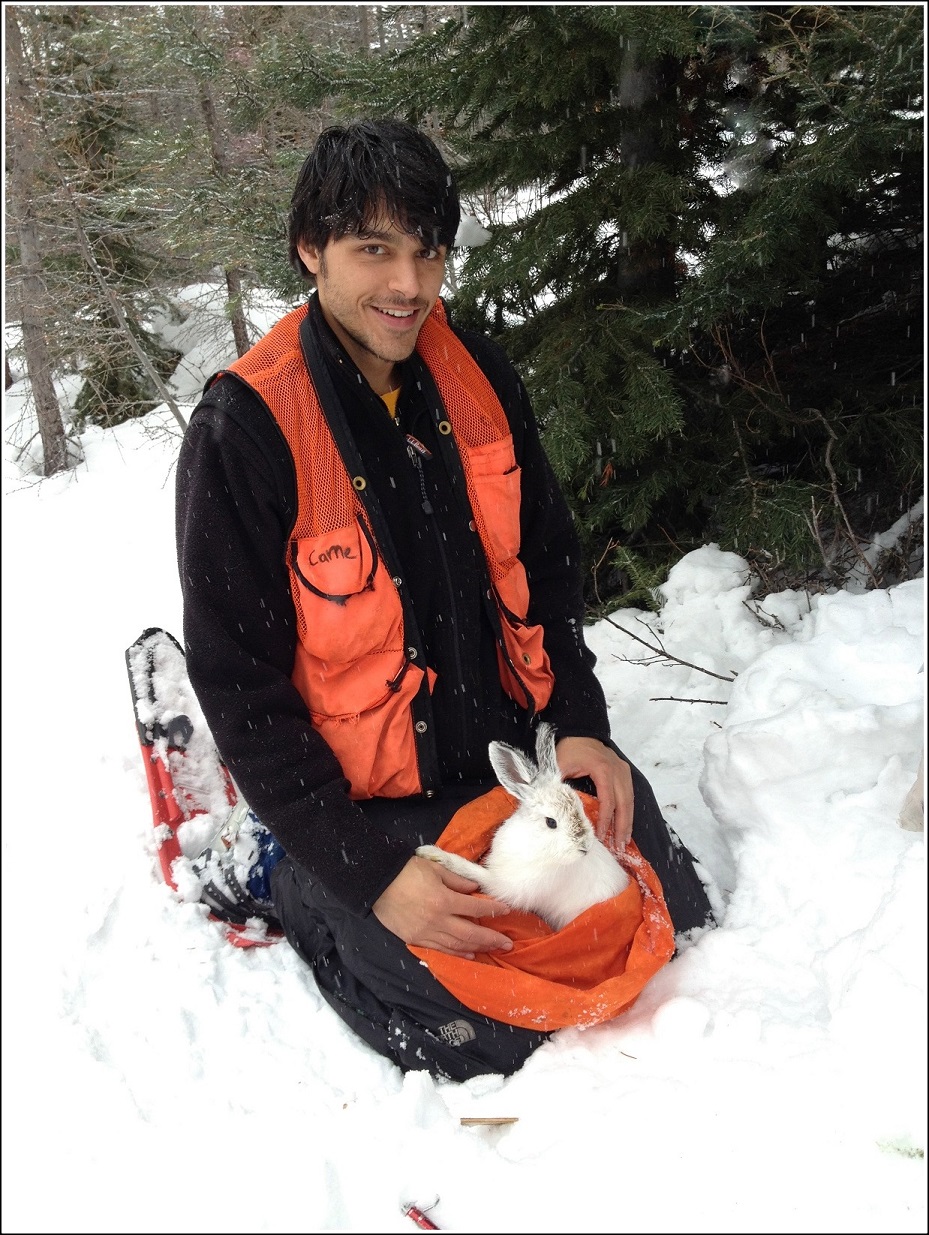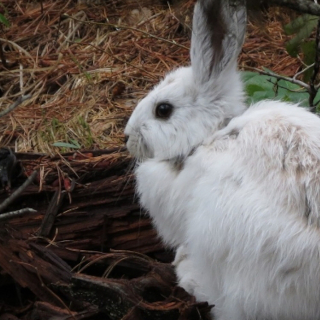Dr. Alexander V. Kumar
Email: avk36@cornell.edu
Google Scholar Profile: Alexander Kumar
Education
Ph.D., Wildlife Biology, University of Montana (2020)
M.S., Fisheries Wildlife & Conservation Biology, North Carolina State University (2015)
B.S., Biological Sciences and Natural Resources (double major) with Distinction in Research, Cornell University (2011)

Research Projects
Drivers of Hare Population Dynamics and Cycles
Cyclic population dynamics have long fascinated ecologists starting with Charles Elton in the 1920s. Population cycles are common across diverse taxa such as insects, birds and mammals and some cyclic species can wreak havoc on natural resources (gypsy moths) and biodiversity conservation (crown-of-thorns starfish). A common feature of many cyclic species is that their cycles tend to diminish and even vanish in portions of their range. Broadly my dissertation seeks to address the cause of these cycle collapses. Hypothesized drivers of cycle collapse include decreasing specialist predators, increasing habitat fragmentation, and changing winter severity. However, many of these studies have only addressed one or two drivers and rely on indices of abundance which can be unreliable. My dissertation considers multiple drivers of cycle dynamics in one unified modeling framework using rigorous direct estimates of density. Specifically, I am testing the effects of predation, habitat, and winter severity on snowshoe hare cycle dynamics in western Montana. I hope that my findings not only further clarify the drivers of the famed snowshoe hare cycle but also provide insight to other cyclic species. And since I am examining factors reducing cycles, my findings provide guidance on reducing population peaks in nuisance species that cause extensive damage.
Effects of Climate Change on Coat Color Phenology of Hares and Other Mammals
Climate change is one of the most pressing challenges society must confront and will likely have many unanticipated consequences. One such consequence relates to snowshoe hares and at least other 21 vertebrate species undergoing seasonal color molts from brown to white as a means of camouflage in environments with seasonal snow. One of the most consistently predicted outcomes of climate change is a reduction in the number of days with snow cover which could create mismatched white individuals on snowless brown backgrounds highly susceptible to predation. My research focuses on phenological cascades caused by changes in forest stand structure influencing snow cover which cascade to influence hares. In addition, I am interested in the effects of climate change on cycle dynamics.
Effects of Forest Restoration on Snowshoe Hares
Ecological restoration has been deemed, "the means to end the great extinction spasm" by E.O. Wilson. It is the process by which we recover ecosystems that have been damaged or destroyed. My research has focused on restoring western larch, a species that has been extensively harvest and negatively impacted by fire suppression in a way that is compatible with focal wildlife inhabiting that area.
For more information check out my blog post.
Research Collaborations
- Human-elephant Conflict in Northeast India – in collaboration with Dr. Varun Goswami and Dr. Divya Vasudev, WCS, India; and Lisa Mills, University of Montana. For more information check out my blog post.
- Spatial Genetic Mark-recapture of Mule Deer – in collaboration with Dr. Amy Vandergast, USGS, San Diego.
- Tiger Leopard Habitat and Space Use Overlap – in collaboration with Dr. Ullas Karanth, WCS, India.
Publications
2020
Kumar, A.V., M. Zimova, J.R. Sparks, L.S. Mills. In Press. Snow-mediated plasticity in phenology does not prevent camouflage mismatch. Oecologia.
Kumar, A.V., K.U. Karanth, and D. Jathanna. In Press. Tigers and Leopards Coexist Despite Interspecific Similarities in Space Use and Habitat Selection. Cat News.
Zimova, M., L. Barnard, B.M. Davis, A.V. Kumar, D.J.R. Lafferty, L.S. Mills. 2020. Using remote cameras to measure seasonal molts. Ecosphere. 11(4): e03084. read
Gigliotti, L.C., N.D. Berg, R. Boonstra, S.M. Cleveland, D.R. Diefenbach, E.M. Gese, J.S. Ivan, K. Kielland, C.J. Krebs, A.V. Kumar, L.S. Mills, J.N. Pauli, H.B. Underwood, E.C. Wilson, M.J. Sheriff. 2020. Latitudinal variation in snowshoe hare (Lepus americanus) body mass: A test of Bergmann’s Rule. Canadian Journal of Zoology. 98(2): 88-95. read
2019
Davis, B. M., A. V. Kumar, and L. S. Mills. 2019. A Camouflage Conundrum: Unexpected Differences in Winter Coat Color Between Sympatric Species. Ecosphere. 10(3): e02658. read
2018
Mills, L.S., E. Bragina, A.V. Kumar et al. 2018. Winter Coat Color Polymorphisms Identify Global Hotspots for Evolutionary Rescue from Climate Change. Science. 359(6379): 1033-1036. read
Kumar, A.V., J.R. Sparks, and L.S. Mills. 2018. Short‐term Response of Snowshoe Hares to Western Larch Restoration and Seasonal Needle Drop. Restoration Ecology 26(1): 156-164. read
2017
Lafferty, D.J.R., A.V. Kumar, S. Whitcher, K. Hackländer, L.S. Mills. 2017. Within-sample Variation in Snowshoe Hare Faecal Glucocorticoid Metabolite Measurements. Conservation Physiology. 5(1): 1-7. read
2013
Kumar, A.V., D.W. Linzey and C.R. Smith. 2013. Bait Preferences and Population Status of Small Mammals in Great Smoky Mountains National Park. Journal of North Carolina Academy of Science. 129(2): 44-52. read
